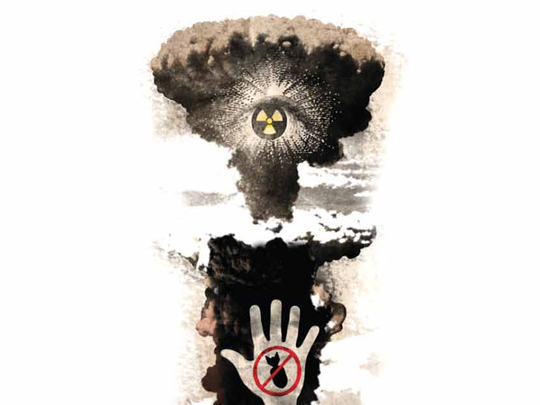
Seventy years ago, on August 6, 1945, humans perpetrated one of the most horrific and shameful acts in their entire history. On that fateful morning, a US military aircraft dropped a new type of bomb on the Japanese city of Hiroshima. The explosive device, cynically named Little Boy, carried only 64 kg of uranium but delivered the equivalent of 15 tons of TNT explosives.
The hellish devastation it produced on the city and its inhabitants was unprecedented and until then unimagined. Still, three days later, another nuclear bomb, this one called Fat Man, technically different from the other, was dropped on another city, Nagasaki. Japan surrendered on the next day, unwilling to witness any more hell on earth.
To conceptualise the monstrosity of such nuclear bombs, it is worth reviewing the immediate impact as well as the delayed effects of that Hiroshima event.
Within one second, the bomb, which exploded 200 metres above ground, produced a fireball that was 280 metres wide and had a core temperature of over a million degrees Celsius. On the ground, temperatures reached 4,000 C, melting everything within sight, whether flesh or metal. Fires raged for hours, burning buildings and animals; birds burst into flames; glass shattered and turned into bullets, spraying people’s bodies — a horror movie played in real time... Immediate casualties were estimated at some 80,000; thousands more suffered all kinds of delayed diseases and died years later.
Indeed, the effect of the bomb was not limited to the hellish fireball, heat and flames that the nuclear chain reactions immediately produced; equally destructive was the radiation (gamma rays and neutrons) that shelled everything, from air to water and soil, and from humans to plants. In fact, the bomb used only 10 per cent of its uranium, the rest was scattered in the air as radioactive material, some of which was rained down into the soil and the water, to be drunk by desperately thirsty people and animals — with debilitating effects. The radiation dose that people absorbed in the inner zone amounted to 100 times what most of us are exposed to in a year.
The ills and sufferings that ensued are too numerous and shocking to describe. They included: liver damage, cardiovascular diseases, thyroid damage, chronic hepatitis, cataracts, months-long diarrhea, and obliterated bone marrow and white blood cells, which rendered immune systems unable to cope with most infections. Cancers of all kinds appeared in thousands of people within a few years.
Reading even this brief account of the Hiroshima bomb’s devastating effects, one might think that humanity would have quickly come back to its senses, wisened up and perhaps even atoned for its sins. To the contrary, the superpowers, particularly the Americans and the Russians, continued their crazed race for bigger, badder bombs.
More shockingly, while there are international treaties banning biological and chemical weapons, cluster bombs, and landmines, none exist on nuclear bombs, only “non-proliferation” treaties that have not prevented a number of countries (Israel, India, Pakistan, North Korea) from joining the “club”, with France, the UK, and China.
As of 2009, the global count of nuclear bombs was estimated at about 24,000, Russia owning 55 per cent of them, the United States 40 per cent. Additionally, the global stockpile of highly enriched uranium is estimated at 1,600 tons, enough to make more than 60,000 bombs. More worrying still is the explosive yield of today’s nuclear weapons: while Hiroshima’s bomb was measured in kilotons of TNT-equivalent, today’s bombs are measured in megatons. The biggest one is Tsar Bomba, which the Soviets exploded in 1961 with a power equivalent to 50 megatons of TNT, producing a fireball 2.3km in diameter.
What should be done about this? Simply: total demolition of all nuclear weapons, and strong international rules preventing them from reappearing. Interestingly, in 2009 Barack Obama spoke of “America’s commitment to seek the peak and security of a world without nuclear weapons.”
He noted: “I’m not naïve. This goal will not be reached quickly — perhaps not in my lifetime.”
This year, a non-proliferation treaty review conference was held in New York, where 159 countries signed a statement calling for serious efforts to be exerted to eliminate the threat of these weapons of mass destruction, stressing that “the only way to guarantee that... is through their total elimination.”
Intellectuals, religious leaders, and opinion makers must use their influence and social capital to push governments to roll back the monstrous hells that have been built and stored. While war is to be abhorred in general, weapons that kill and destroy indiscriminately must particularly be prohibited and removed from military stores.
For instance, Islam has clear injunctions against killing any noncombatants (women, children, old folks, monks and priests) or destroying any property (including trees) in war: “do not transgress limits,” the Quran intones, “for Allah loveth not transgressors.”
The moral argument against nuclear weapons was eloquently expressed by Tadatoshi Akiba, the mayor of Hiroshima from 1999 to 2011: “As long as we have nuclear weapons on this earth, one could claim that no real life is actually thriving on earth.”
Let us use this sad anniversary to resolve to actively free the world from nuclear weapons and to make them a forgotten error of the past.
Nidhal Guessoum is a professor at the American University of Sharjah. You can follow him on Twitter at: www.twitter.com/@NidhalGuessoum.








